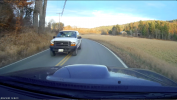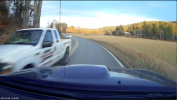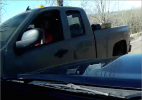30P vs 60P is a resolution of time. If I look at the footage of accident videos posted on YouTube, you can drop the frame rate down to 15P and still get a clear idea of what happened. Now if a car flipped over, 60P or better yet 120P would give a really cool slow motion of it happening. However the bottom line is that as far as a video for the insurance company or courts, I just don't see 60P as that critical. I want to point out that in full sunlight, the shutter speed of the CMOS sensor is very short, maybe around 1/1000 of a second (give or take), so the sharpness of each frame is still there. At night, longer exposures are required to capture the light, so night video isn't as good.
Now as for 4K vs 1080P, most of the time the accident videos don't matter as to the resolution. Even lowly standard definition shows exactly what happened. It's only a hit and run where having the detail of the license plate pays off OR I capture an event in the distance that the extra detail pays off.
@BobDiaz, I've been wanting to respond to your post for several days but needed to wait until I had a bit of time to do so. Basically, I strongly disagree with your viewpoints here as I find them overly simplistic and feel you are making extremely generalized assumptions regarding what may truly be required in evidence capture.
When you issue a statement that, "you can drop the frame rate down to 15P and
'still get a clear idea of what happened" it is clear that you have never been in a situation vis-a-vis your dash camera where you have had to
legally prove a case to Law Enforcement personnel, state prosecutors or go up against an aggressive defense attorney regarding the use of your dash camera footage in a criminal matter. A remark like,
"Even lowly standard definition shows exactly what happened" strikes me as completely out of touch with the realities of what can happen out here in the real world and I believe your notion that higher frame rates are not "critical" in courtrooms or for insurance claims to be sorely missing the mark considering the negative consequences of not being able to prove one's case.
It is one thing to "
see what happened" at 15 fps (or 30 fps) during a typical fender bender or even worse but it is an entirely different matter when you must provide indisputable, actionable legal evidence. Fifteen frames per second happens to be the bare minimum rate that is required to create the illusion of continuous motion on screen, but that is about it. Slower frame rates, including 30fps tend to be subject to excessive motion blur and jutter. Slow frame rates miss key moments that tell the full story of an event. It has been demonstrated that in film and video each increase in the number of frames captured per second gives you both smoother motion and most importantly for our purposes as dash cam owners, 60fps provides more individual frames that are sharper and that reveal more fine detail.
While shutter speed plays a role here, the fact is that small, relatively primitive digital dash cameras that use electronic rolling shutters are highly prone to motion blur when compared side by side with the global shutters found in more sophisticated cameras. Shutter speeds in rolling shutter cameras have far less ability to freeze motion than in global shutter cameras by the very nature of how they function.
Other factors are at play here when it comes to achieving sharp individual frame capture. True 4K and higher cameras provide high
spatial resolution (also known as angular resolution) while higher frame rates provide what is called
temporal resolution. The combination of spatial resolution and temporal resolution is what is required to give us the kind of clarity of image capture many of us seek and eventually hope to see from our dash cams.
I should explain at this point why I so adamantly disagree with your argument against the need for higher frame rates.
I first became interested in dash cams about six years ago because I was being harassed and threatened by a highly disturbed individual I once did some business with who was angry that I hired an attorney after he broke a contract. It is a long complicated story involving threats, harassment, vandalism and stalking. One of the things that was going on was that this individual would swerve his vehicle at me when coming from the opposite direction in an attempt to run me off the road or would nearly side swipe me within inches as a form of intimidation. Eventually, out of necessity I started using an older cam-corder in my vehicle and then actual dedicated dash cams but it took a very long time to get the police to take action against this individual because law enforcement requires actual, definitive evidence before they have "probable cause" to make an arrest. And don't think it is merely capturing a license plate is all that is necessary. In a legal matter that ends up in court it comes down to definitively proving that a specific individual vehicle was doing this as well as identifying who was driving. Once an arrest is made the evidence goes to a prosecutor who has specific requirements if they ever hope to achieve a conviction. Of course, once a defense attorney gets involved he will do whatever he can to dispose of your video evidence in court.
I can tell you with certainty that if I had a 60 fps dash cam it would have made a huge difference. As it was, the case came down to individual frame captures presented as stills, one by one in sequence. Remember, many things that happen out on the road at high speed take only a second or two in real time and happen in the blink of an eye when you experience an incident. The ability to sort thorough 60 sharper individual frames captured during each second of an event is far more desirable than having only thirty motion blurry frames to work with that are less clear than what can be captured at 60fps.
While one might try to argue that the case I outline here is highly unique, I have learned over the last six years of dash cam ownership that it most certainly is not. Many times I have found myself in situations where higher frames rates, lower motion blur and greater detail are
the most important thing one would want in a dash cam. Fortunately, the other events I refer to were close calls but if something were to actually happen I would want to capture the best footage possible.
One example of what I am talking about was the time an apparent drunk nearly hit me head-on rounding a blind curve at high speed. Instead, he just came very close to side swiping me but I have no way to know if he would have stopped or kept on going. Certainly, higher frames rates providing better detail would be extremely valuable in a situation like this. The entire event where the truck almost hits me lasts exactly one second. In this instance, there was a license plate to capture but perhaps more importantly was the name of a business and logo on the side of the truck.
In your other thread
questioning the need for 60 fps I posted a link to a well crafted web page that allows one to see, manipulate and simultaneously compare frame rates and motion blur. I highly recommend it for anyone reading this thread who hasn't taken the time to have a look at it.
https://frames-per-second.appspot.com/. It demonstrates the critical differences between frame rates with such absolute clarity not much more needs to be said about it.
Here's a grab - 15 fps vs 24 fps vs 30fps vs 60fps:

The dash cam I bought six years ago shot 1080P @ 30 fps and was rather impressive in certain ways but it was really very primitive and sub par by today's standards. It has been exciting and gratifying to witness the ongoing image improvements we've seen over the last six years along with dramatically improved night performance and as a dedicated dash enthusiast who has been through quite a few different models and has become especially enamored with the quality and reliability of the Mobius I am personally excited by the prospect of 60 fps (or higher!). I can't wait for the Mobius 2! In fact, from my experience over these last six years and what I now know I don't believe I would ever by another dash cam going forward that can't achieve at least 60 fps considering where the technology is right now and where it is headed.
For these reasons it is hard for me to understand the mentality of advocating for what will be an increasingly obsolete frame rate specification going forward when the whole point of having a dash cam is to capture
the absolute best quality legally actionable evidence we can if the need should ever arise either to protect ourselves from liability or to PROVE other's culpability in court or for an insurance claim. What is required is that you want the kind of absolute proof that prevents the other party from having any possible opportunity for legal deniability. When push comes to shove in a legal matter there is far more at stake than capturing just "what happened" without the required level of proof and detail. Dismissing and discounting a vastly improved next generation frame rate specification is something that I just don't quite understand.










